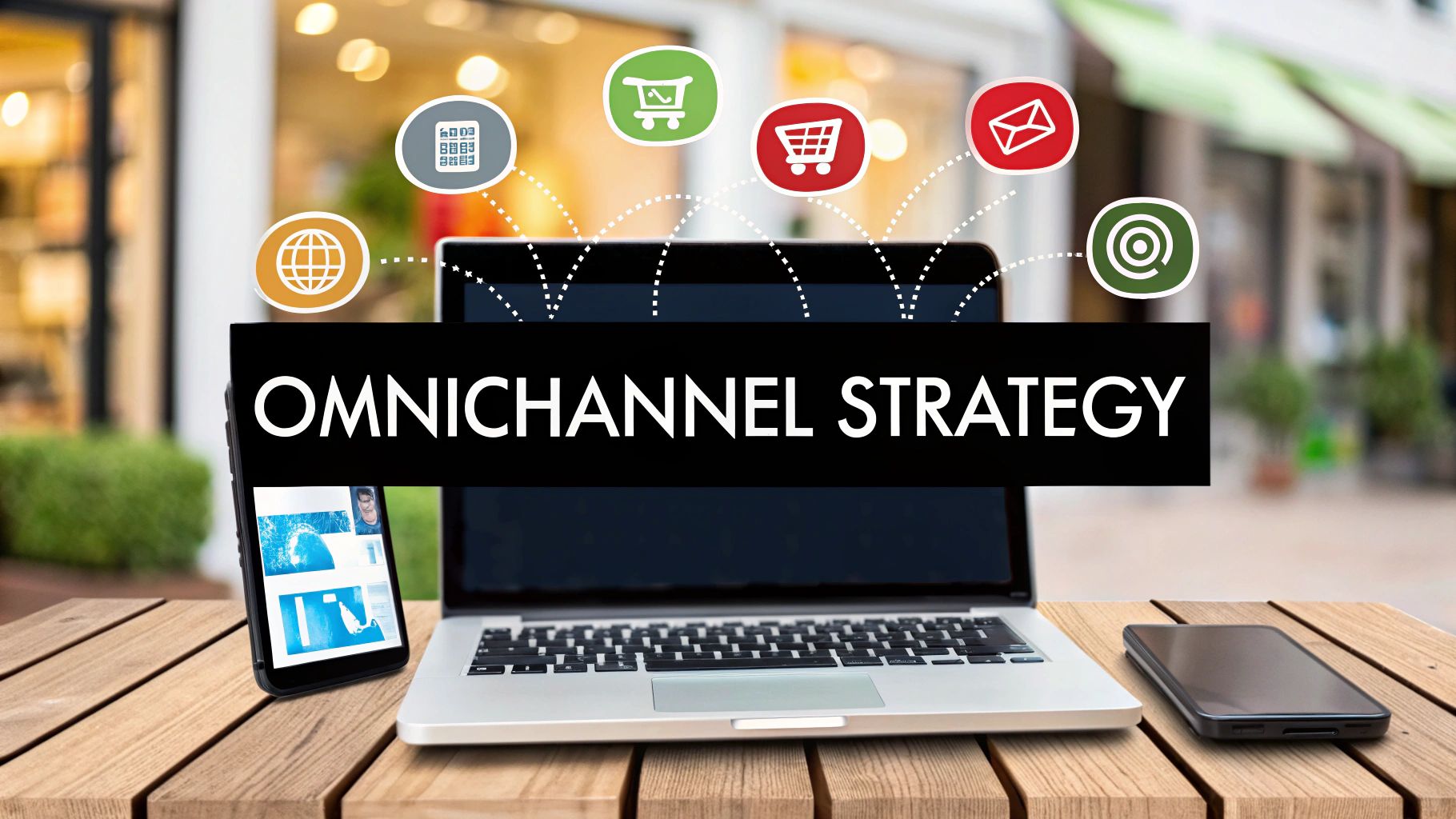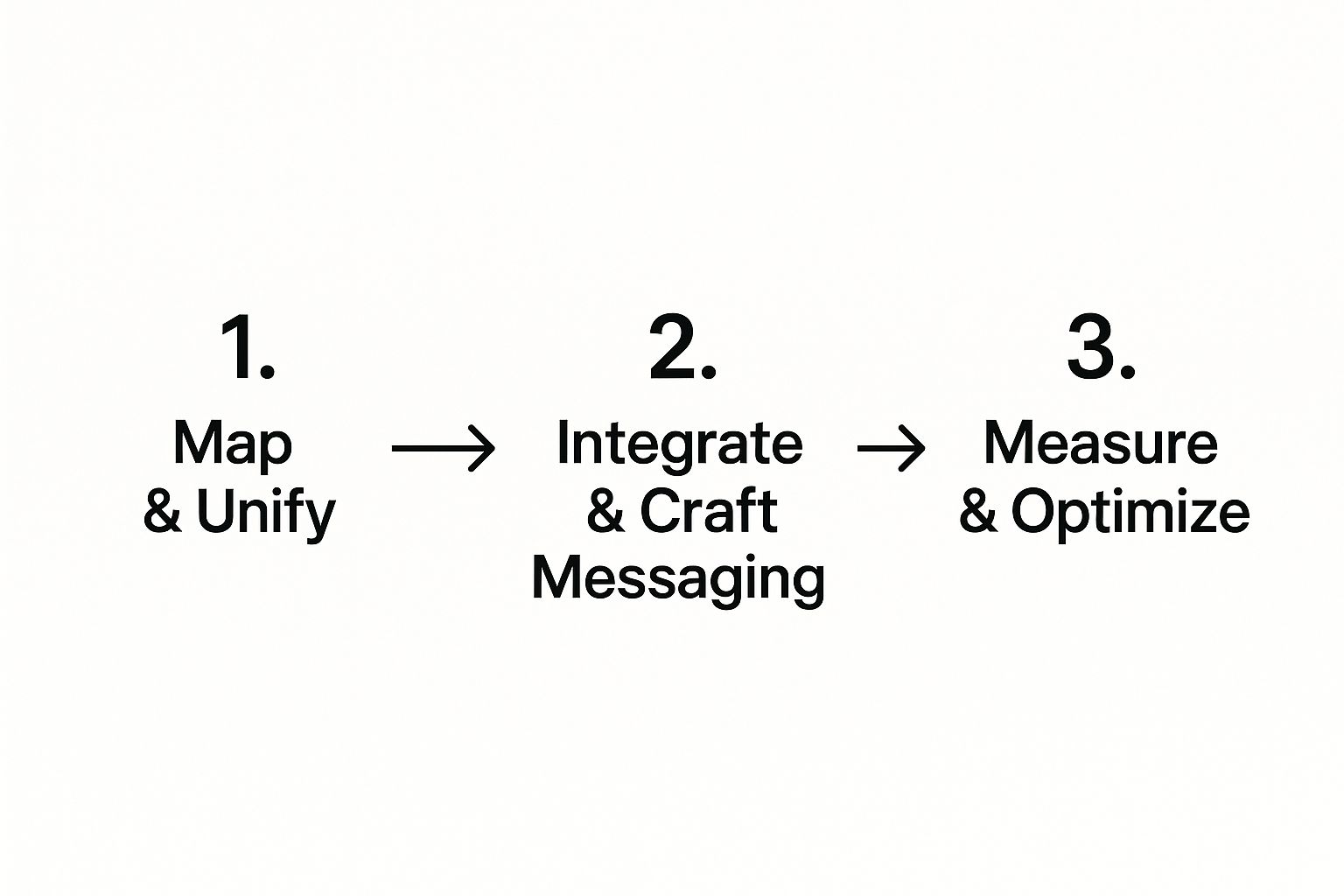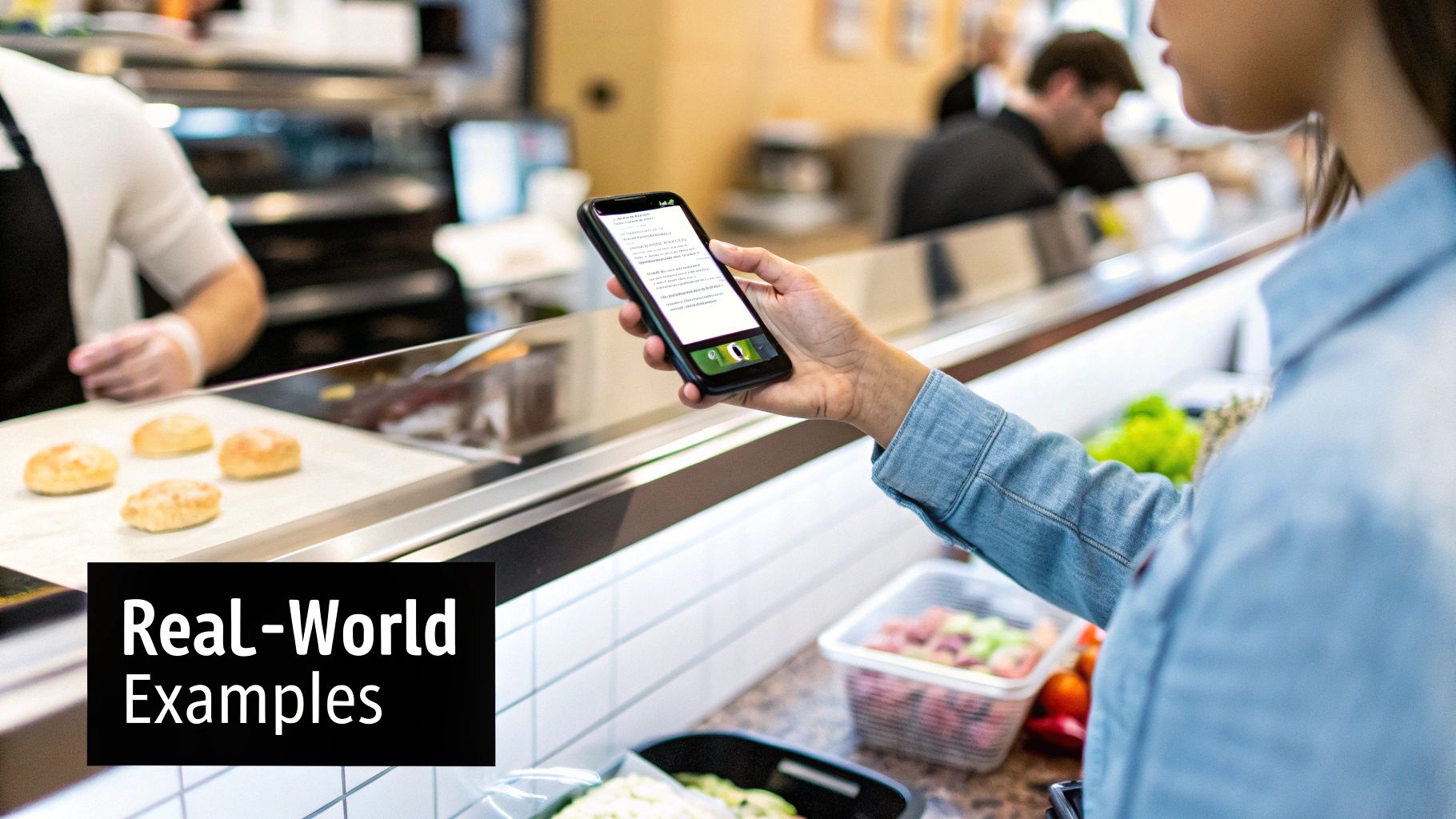
Your Guide to Omnichannel Marketing Strategy
Build a winning omnichannel marketing strategy. Unify channels, integrate data, and create seamless customer experiences that boost loyalty and drive sales.
An omnichannel marketing strategy is all about connecting your marketing channels to create one single, unified customer experience.
Don't just think of it as being on multiple platforms. Think of it as conducting a symphony where your website, mobile app, and physical store all play in perfect harmony. The customer? They're the conductor.
Understanding The Core Of Omnichannel

Lots of businesses operate on multiple channels, but that doesn't automatically mean their approach is omnichannel. A true omnichannel strategy goes way beyond simply having a presence on social media, email, and in-store. It weaves these touchpoints together so the customer's journey is fluid and completely uninterrupted.
Let's paint a picture. A customer adds a product to their online cart on their laptop but gets distracted and doesn't check out. Later, they get a personalized push notification on their phone—a gentle nudge about the item they left behind.
The next day, they walk into your physical store. A sales associate, armed with the right tech, can see their abandoned cart and offer to help them complete the purchase right then and there. That connected, helpful experience is the heart and soul of omnichannel.
Multichannel Versus Omnichannel
It's really easy to mix these two up, but the difference is critical. A multichannel approach is like having separate conversations in different rooms. Omnichannel is one continuous conversation that moves with the customer from room to room.
To make this crystal clear, let's break it down.
Omnichannel vs Multichannel A Quick Comparison
| Attribute | Multichannel Marketing | Omnichannel Marketing | | :--- | :--- | :--- | | Core Focus | Brand-centric. Focuses on maximizing reach on each individual channel. | Customer-centric. Focuses on creating a seamless customer journey across all channels. | | Channel Integration | Channels operate independently, often in silos. Little to no data sharing. | Channels are fully integrated and work together. Data is shared to inform the next interaction. | | Customer Experience | Inconsistent. The experience can feel disjointed as the customer moves between channels. | Consistent and unified. The experience feels like a single conversation with the brand. | | Business Goal | Increase engagement on as many channels as possible. | Increase customer loyalty and lifetime value by improving the overall experience. |
See the shift? It’s more than just a fancy marketing term; it's a fundamental change in focus from the brand's channels to the customer's real-world experience.
Multichannel is about giving the customer choices on where to engage. Omnichannel is about ensuring that engagement is seamless and intelligent across those choices, creating a single, persistent brand experience.
To truly get this right, you have to start by understanding which marketing channels work best together.
The impact is huge. Companies with strong omnichannel strategies retain 89% of their customers, a massive leap from the 33% retention rate for those with weaker approaches. This isn't just about driving one-off sales; it's about building powerful, lasting customer loyalty.
This customer-first viewpoint is the bedrock of every successful omnichannel marketing strategy, making it an absolute must for modern business growth.
Why You Can't Afford to Ignore Omnichannel Anymore
Let’s be honest. In a world where your customers jump between your Instagram, your website, and your physical store in the span of an hour, a disconnected experience just doesn't cut it. An omnichannel strategy has gone from a "nice-to-have" buzzword to a fundamental requirement for staying in business.
The modern customer journey is anything but linear. It’s a messy, fluid path. Someone might see your ad on TikTok during their commute, browse your products on their laptop at lunch, and then pop into your store on the way home. If each of those touchpoints feels like starting over from scratch, you’re creating frustration—and frustrated customers don't stick around.
A true omnichannel approach erases those frustrating gaps. It transforms a series of separate interactions into one continuous, intelligent conversation.
The Real-World Business Impact
Moving beyond a clunky, multi-channel setup isn't just about making customers happy; it's about building a healthier, more profitable business. When you get this right, the results show up on your bottom line.
A solid omnichannel strategy delivers in three key areas:
- It keeps customers coming back. When the experience is consistently great everywhere, you build real trust. That trust is the foundation of loyalty.
- It creates more valuable customers. The data is clear: omnichannel shoppers are worth more. They spend more per purchase and buy more often because you’ve made it incredibly easy and personal for them.
- It drives more sales, period. By removing friction, you make it easier for people to say "yes." Think about it—a customer who can start building a cart on their phone and seamlessly complete the purchase in-store is far less likely to abandon it.
It's not just a theory. Companies that truly nail personalization see an average revenue boost of 46% in customer spend. This shows that a unified, data-smart approach directly translates to more money in the bank by making every interaction count.
The Goldmine: Deeper Customer Insights
Maybe the most powerful benefit of going omnichannel is the incredible clarity it gives you. When all your systems are talking to each other, you stop seeing random clicks and transactions. Instead, you get a complete, 360-degree view of each customer's journey.
You start to see the patterns. You learn which channels they use for discovery versus which they prefer for the final purchase. You might spot a customer who only responds to email deals for one product category but always buys another in-person.
This unified view is what fuels genuine personalization. It lets you deliver marketing that feels helpful, not creepy. Instead of blasting out a generic discount, you can offer a timely promotion on an accessory that perfectly complements a product they just bought online. That’s the kind of relevance that makes a brand stand out.
Ultimately, an omnichannel approach is about future-proofing your business. It’s about aligning your entire operation with how people actually shop today. Every touchpoint becomes an opportunity to build a stronger relationship, turning a one-time buyer into a lifelong fan. In a noisy market, that seamless experience is your ultimate competitive edge.
The Pillars of a Powerful Omnichannel Strategy

A great omnichannel strategy doesn't just appear out of thin air. It’s built on purpose, with a rock-solid foundation.
Think of it like building a house. You wouldn't just start throwing up walls, right? You need strong support pillars, or the whole thing will come crashing down. The same goes for your marketing.
To craft that seamless experience your customers crave, you have to nail three foundational pillars. Get these right, and they’ll work together to turn a bunch of disconnected channels into one smart, customer-focused machine.
Pillar 1: Unified Customer Data
The first and most important pillar is unified customer data. This is your single source of truth, the engine that powers every personalized interaction. Without it, you're just guessing, and your channels will never truly work together.
Every time a customer interacts with your brand—a website visit, an in-store purchase, a social media comment—it creates a little piece of a puzzle. In most companies, those puzzle pieces are scattered everywhere. Marketing has a few, sales has some others, and customer service is holding another pile entirely.
A unified data approach, usually handled by a Customer Data Platform (CDP), scoops up all those scattered puzzle pieces and puts them together. It builds a complete, 360-degree picture of each customer, letting you see their entire journey and even anticipate what they'll do next.
This complete view isn't a nice-to-have; it's essential. It’s what lets a support agent see the exact products a customer was browsing online just moments before they called. It’s how your website knows to recommend items based on something they bought in your physical store last week.
Pillar 2: An Integrated Technology Stack
Once you have a clear picture of your customer, you need the right tools to act on it. That brings us to the second pillar: an integrated technology stack. Your data is only useful if your tools can actually use it, and that means they all need to talk to each other.
Your tech stack is the central nervous system of your whole operation. It’s everything from your e-commerce platform and CRM to your email service and inventory system. If these systems are siloed, you’ll create frustrating gaps for the customer.
Here’s a classic example: a customer buys the last jacket in one of your stores. If your inventory system doesn't immediately tell your e-commerce site, another customer could buy that same out-of-stock jacket online. You know what comes next—a canceled order and a very unhappy customer.
An integrated stack makes sure information flows between all your systems in real-time.
- Marketing Automation Platforms: These tools take your unified data and trigger personalized messages across different channels. You can learn more in our guide to marketing automation strategies.
- Customer Relationship Management (CRM): Your CRM needs to sync with every touchpoint so your sales and support teams always have the latest customer information.
- Inventory Management Systems: Real-time stock data must be available to both your online and offline channels. This is key for preventing stockouts and offering services like "buy online, pick up in-store."
- Point of Sale (POS) Systems: Data from in-store purchases has to feed back into the customer's central profile to help shape future digital marketing.
When all these pieces are connected, they create a single ecosystem that powers a smooth, consistent experience.
Pillar 3: A Consistent Customer Journey
The final pillar is where your data and technology come to life for the customer: a consistent customer journey. This is where they actually feel the benefits of all your behind-the-scenes work. It’s about making sure your messaging, branding, and service feel the same everywhere they meet you.
Consistency doesn't mean repeating the exact same message on every channel. It means adapting your message for the context of the channel while keeping your brand voice and story straight. A promo you run on Instagram should be instantly recognizable—and redeemable—on your website and in your physical stores.
This pillar is all about execution. It means breaking down the walls between your internal teams so that everyone, from marketing to in-store associates, is on the same page. A customer shouldn't have to explain their problem to three different people as they move from a chatbot to an email to a phone call.
At the end of the day, a powerful omnichannel strategy is an ecosystem where data, technology, and execution are all perfectly in sync. By building on these three pillars, you can go from just being on multiple channels to delivering truly seamless experiences that create loyal customers and drive real growth.
Building Your Omnichannel Strategy Step by Step
Switching your marketing from a bunch of separate channels into one cohesive omnichannel machine doesn't happen by accident. It takes a clear roadmap. The whole process is about connecting the dots—customer habits, data points, and channel experiences—to create a single, seamless picture for your customer.
This framework will walk you through building an omnichannel marketing strategy that moves beyond theory and into real, profitable action. Let's get into it.
Stage 1: Map the Customer Journey
Before you can create a seamless experience, you have to understand the path your customers are already on. Customer journey mapping is all about visualizing every single interaction someone has with your brand, from the first time they hear your name to the moment they become a loyal fan.
Think like a detective. Your mission is to uncover every touchpoint, big or small. Where do they first discover you? What device are they using when they browse your site? What's holding them back right before they decide to buy?
To get this right, you have to put yourself in their shoes. Building out detailed buyer personas is a huge part of this. If you need a hand with that, our guide on how to create buyer personas breaks it all down for you.
Your map should clearly identify:
- Touchpoints: Every point of contact, from a social media ad to walking into your physical store.
- Motivations: What is the customer trying to accomplish at each step?
- Pain Points: Where are they getting stuck or frustrated?
Finding those moments of friction is where the gold is. Is your checkout process a nightmare on mobile? Do your in-store staff know about the promotions running online? These are the exact gaps an omnichannel strategy is built to fix.
Stage 2: Unify Your Data
Okay, so you've mapped the journey. Now you need the data to back it up. Right now, your customer data is probably all over the place—in your CRM, your e-commerce platform, social media analytics, your in-store POS system. You can't have a true omnichannel strategy when your data lives in separate silos.
The goal here is to create a single customer view (SCV). This is a unified profile that pulls together every interaction from every channel, giving you a complete, 360-degree look at each person. It’s the difference between seeing a random website visitor and knowing, "That's Jane. She bought hiking boots last month and just clicked on our email about waterproof jackets."
This unified data is the engine for personalization. One report found that companies that nail personalization see an average customer spend boost of 46%. A single customer view is what makes that kind of targeting possible.
This step often means bringing in technology like a Customer Data Platform (CDP). These tools are built specifically to grab, clean, and merge customer data from all your different sources into one clean profile.
Stage 3: Integrate Key Channels
With a clear customer map and unified data, it's time to connect the channels your audience actually uses. And remember, omnichannel isn't about being everywhere. It's about creating a flawless experience on the platforms that matter most to your customers.
Zero in on the channels you flagged as critical during your journey mapping. The key word here is integration. Your channels need to talk to each other, and they need to do it in real-time.
Here are a few practical examples of what that looks like:
- Inventory Sync: Your website should show what's actually in stock at your local store, making things like "buy online, pick up in-store" possible.
- CRM and POS Connection: When a customer buys something in-store, that info should instantly update their profile in your CRM, which then changes the ads and emails they see next.
- Cross-Channel Support: A customer service rep on live chat should be able to see a customer's entire history, even if the conversation started on Twitter or over email.
This infographic lays out the core flow for getting your strategy up and running.

As you can see, mapping the journey and unifying your data form the foundation. From there, you can integrate your channels and create consistent messaging, all while continuously optimizing your approach.
Stage 4: Craft Consistent and Contextual Messaging
Consistency is the signature of a great omnichannel experience. Your brand's voice, look, and offers should feel the same everywhere. But "consistent" doesn't mean "identical."
The real magic is in contextual messaging. This means you're tailoring your communication to the channel and the customer's specific place in their journey. For instance, a deep-dive product tutorial makes sense for YouTube, but a quick, punchy visual is what you want for Instagram.
The message should always feel aware of what the customer did before. If they just abandoned their shopping cart, a gentle reminder email with a small discount is way more effective than a generic newsletter blast. That kind of thoughtful approach makes your marketing feel helpful, not creepy.
Stage 5: Measure, Analyze, and Optimize
Finally, an omnichannel strategy is never "set it and forget it." It’s a living, breathing system that you have to constantly monitor and tweak. You need to be tracking metrics that show you the whole picture, not just how one channel is performing on its own.
Key omnichannel metrics to keep an eye on include:
- Customer Lifetime Value (CLV): Are your omnichannel customers ultimately worth more to the business?
- Customer Retention Rate: Does a seamless experience make people stick around longer?
- Cross-Channel Conversion Paths: How many channels do people typically touch before they make a purchase?
Use A/B testing to experiment with different messages, offers, and channel combinations. Dig into the data to see what’s working, and don't be afraid to make changes. Building any solid marketing plan means starting with a good foundation, and it never hurts to check out a broad resource like this Founder’s Startup Marketing Strategy Guide for more perspective. Continuous optimization is what turns a good strategy into a great one.
Choosing the Right Channels for a Global Audience
A killer omnichannel strategy isn't about being everywhere at once. It's about being in the right places. And when you’re talking to a global audience, getting this right is everything.
You can't just copy-paste your channel plan from one country to another. Communication habits are baked into local culture. What feels natural in North America can feel completely alien in Northeast Asia. The whole point is to meet people where they already are, on the platforms they use every single day. If you don't, you're not just missing out—you're making things harder for your customers.
Why Localization Is Non-Negotiable
Think of each channel as a different kind of conversation. Email feels more formal. A WhatsApp message is quick and personal. Forcing someone to use a channel that feels weird to them is like trying to close a business deal in the middle of a rock concert. It just doesn't work.
You have to roll with the regional trends, and they are powerful. In Latin America, WhatsApp is king, with over 93.4% of the population using it. You simply can't ignore it. In Northeast Asia, WeChat is the entire ecosystem for its 1.3 billion users. And back in North America, good old SMS still pulls a nearly perfect 98% open rate, while 74% of people still prefer email for things like receipts and order confirmations. You can dig deeper into these global communication trends on mailjet.com.
The takeaway? A great global strategy is really just a bunch of great local ones stitched together.
How to Select the Right Channels
So, how do you pick? It all starts with good old-fashioned research. Stop guessing and start digging into the data for each market you’re in.
Here’s a simple game plan:
- Follow Your Data: Look at your analytics. Where is your traffic coming from? Which channels are already working for you in different countries? Find the patterns.
- Do Your Homework: Figure out the go-to platforms in your key regions. Tools like Statista or GWI are goldmines for this kind of data on social media, messaging apps, and email habits.
- Just Ask: The easiest way to know what your customers want is to ask them. A simple survey can tell you exactly where they want to hear from you about new offers, customer support, or anything else.
- Start Small, Then Scale: Don't try to launch on ten new channels tomorrow. Pick one or two promising ones for a specific region, plug them into your strategy, and see what happens. Measure everything. If it works, expand.
And in mobile-heavy regions, your app has to be part of the conversation. Getting that right is its own art, which is why we break down the most effective mobile app marketing strategies you can use.
When you tailor your channels to each market, your message actually lands. People engage, and your investment pays off.
Real World Examples of Omnichannel Marketing

Theory is great, but seeing omnichannel marketing fire on all cylinders in the wild is where it really clicks. The best brands show us that this isn't just a marketing buzzword; it’s a core business strategy that builds fiercely loyal customers.
And there's no better stress test for this than the holiday shopping season. When sales events are at their peak, companies with a well-oiled omnichannel machine don’t just survive—they pull away from the competition. This is when a seamless link between digital and physical becomes a massive advantage.
Starbucks and the Digital Coffee Run
Starbucks offers a masterclass in blending its physical cafes with the digital world. The brand’s mobile app isn't just an app; it’s the heart of their entire strategy. It lets customers order ahead, pay, and rack up rewards, all without ever pulling out a wallet.
Think about the daily commuter. They can place their order on the train, walk into the store, and grab their custom drink without breaking stride. That’s not just convenient; it’s a small moment of delight that turns a routine purchase into a reinforcing habit.
The app also gives Starbucks a direct line into customer habits, letting them send personalized offers that actually feel relevant. By tying together the app, the in-store experience, and the rewards program, Starbucks has turned your phone into its most powerful sales channel.
Target’s BOPIS and Curbside Dominance
Target has cemented its retail dominance by mastering the art of connecting its website to its thousands of physical stores. Their "Buy Online, Pickup In-Store" (BOPIS) and Drive Up services are perfect examples of an omnichannel strategy built around what customers crave most: speed and convenience.
During the busiest shopping seasons, these services aren't just a nice-to-have; they're essential. The holiday rush proves it. Cyber Monday sales recently hit a staggering $13.3 billion, with a huge chunk of that driven by these integrated pickup options. In fact, curbside pickup handled nearly 38% of all online orders the day before Christmas Eve, a time when shoppers absolutely cannot afford delays. You can dig into more of these omnichannel retail statistics on emarsys.com.
By turning every single store into a mini-distribution hub, Target doesn't just get orders out faster. They also create a fresh opportunity for you to pop inside and grab a few extra things while you're there.
This level of operational excellence shows that a winning omnichannel strategy is about much more than consistent brand messaging. It’s about delivering a smarter, integrated service that genuinely makes customers' lives easier.
Frequently Asked Questions
Even the best omnichannel strategies run into a few common roadblocks. Let's tackle some of the questions that come up time and time again so you can move forward with a clear path.
What Is the Biggest Challenge in Omnichannel Implementation?
Nine times out of ten, the biggest hurdle is data integration. Most companies are sitting on siloed data, meaning their customer information is locked away in separate systems—the e-commerce platform, the in-store POS, the CRM, the email marketing tool. This fragmentation makes it impossible to see the full picture of any single customer.
To deliver that seamless experience everyone talks about, you first need a unified view of your customer. That usually means investing in a Customer Data Platform (CDP) and, just as importantly, getting different departments to work together from a single, shared customer profile.
How Can a Small Business Get Started?
You don't need to be everywhere at once. In fact, you shouldn't be. The smartest way for a small business to start is by focusing on the handful of channels where your customers already spend their time. Map out the customer journey for just one of your top products, and make sure that experience feels connected across your website, email, and social media.
Start with a few simple but high-impact integrations:
- Let customers buy online and pick up in-store (BOPIS).
- Use a live chat tool that can pull up a customer's recent order history.
- Make sure your in-store team knows about the promotions you're running online.
Nail the connection between two or three core channels before you even think about expanding your omnichannel marketing strategy.
What Metrics Best Measure Omnichannel Success?
While things like email open rates still have their place, real omnichannel success is measured by metrics that reflect the health of the entire customer relationship, not just a single channel.
Shift your focus to these KPIs:
- Customer Lifetime Value (CLV): This is almost always significantly higher for customers who shop across multiple channels.
- Customer Retention Rate: A smooth, connected experience is one of the most powerful drivers of loyalty.
- Cross-Channel Conversion Rates: This helps you see how people move between touchpoints on their way to making a purchase.
You'll also need solid attribution modeling that can connect what someone does online to what they end up buying in-store.
Ready to automate your content across every channel? ViewPrinter provides the AI-powered tools you need to create, schedule, and distribute engaging social media content seamlessly. Start building your viral presence today.